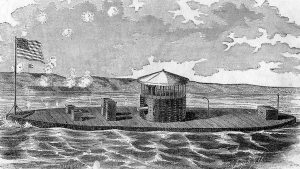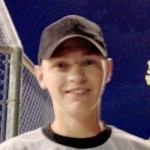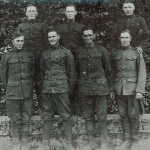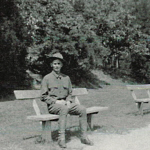fate
 The worst fate a ship can suffer is to end up at the bottom of the sea. Nevertheless, it is a hazard that goes with the territory. Most of these lost ships simply litter the ocean floor, never seeing the light of day again, but once in a while, a ship…or part of a ship finds itself being raised up from the bottom again. Such was the case with USS Monitor, a Civil War era naval warship, that sunk to a watery grave in a storm on March 9, 1862, taking with it, 16 members of it’s crew, who were afraid to go topside in the storm.
The worst fate a ship can suffer is to end up at the bottom of the sea. Nevertheless, it is a hazard that goes with the territory. Most of these lost ships simply litter the ocean floor, never seeing the light of day again, but once in a while, a ship…or part of a ship finds itself being raised up from the bottom again. Such was the case with USS Monitor, a Civil War era naval warship, that sunk to a watery grave in a storm on March 9, 1862, taking with it, 16 members of it’s crew, who were afraid to go topside in the storm.
A short nine months before the tragedy of the USS Monitor, the ship had been part of a revolution in naval warfare. On March 9, 1862, it dueled to a standstill with the CSS Virginia in one of the most famous moments in naval history. It was the first time two ironclads ships faced each other in a naval engagement. During the battle, the two ships circled one another, jockeying for position as they fired their guns, but the cannon balls were no match for the ironclad ships, and they simply deflected off of the sides. In the early afternoon, the Virginia pulled back to Norfolk. Neither ship was seriously damaged, but the Monitor effectively ended the short reign of terror that the Confederate ironclad had brought to the Union navy. What a strange battle that must have been.
The USS Monitor was designed by Swedish engineer John Ericsson. Probably the most strange part of the design was the fact that Monitor had an unusually low profile, rising from the water only 18 inches. The ship sat so low to the water, that it could easily have resembled a submarine. The flat iron deck had a 20 foot cylindrical  turret rising from the middle of the ship. The turret housed two 11 inch Dahlgren guns. The shift had a draft of less than 11 feet so it could operate in the shallow harbors and rivers of the South. It was commissioned on February 25, 1862, and arrived at Chesapeake Bay just in time to engage the Virginia. After the famous duel with the CSS Virginia, the Monitor provided gun support on the James River for George B. McClellan’s Peninsular Campaign. By December 1862, it was clear the ship was no longer needed in Virginia, so she was sent to Beaufort, North Carolina, to join a fleet being assembled for an attack on Charleston.
turret rising from the middle of the ship. The turret housed two 11 inch Dahlgren guns. The shift had a draft of less than 11 feet so it could operate in the shallow harbors and rivers of the South. It was commissioned on February 25, 1862, and arrived at Chesapeake Bay just in time to engage the Virginia. After the famous duel with the CSS Virginia, the Monitor provided gun support on the James River for George B. McClellan’s Peninsular Campaign. By December 1862, it was clear the ship was no longer needed in Virginia, so she was sent to Beaufort, North Carolina, to join a fleet being assembled for an attack on Charleston.
The Monitor was an ideal type of ship in the sheltered waters of Chesapeake Bay, but the heavy, low-slung ship was no good in the open sea. Knowing that, the USS Rhode Island towed the ironclad around the rough waters of Cape Hatteras…a plan that would prove disastrous. As the Monitor pitched and swayed in the rough seas, the caulking around the gun turret loosened and water began to leak into the hull. More leaks developed as the journey continued. High seas tossed the craft, causing the ship’s flat armor bottom to slap the water. Each roll opened more seams, and by nightfall on December 30, it was clear that the Monitor was going to sink. That evening, the Monitor’s commander, J.P. Bankhead, signaled the Rhode Island that they needed to abandon ship. The USS Rhode Island pulled as close as safety allowed to the stricken USS Monitor, and two lifeboats were lowered to retrieve the crew. Many of the sailors were rescued, but some men were too terrified to venture onto the deck in such rough seas. The Monitor’s pumps stopped working, and the ship sank before 16 of its crew members could be rescued. It amazes me that a ship that could deflect cannon balls, was taken  down by loosened calking.
down by loosened calking.
On this day in 2002, the rusty iron gun turret of the USS Monitor rose up from the bottom of its watery grave, and into the daylight for the first time in 140 years. The ironclad warship was raised from the floor of the Atlantic, where it had rested since it went down in a storm off Cape Hatteras, North Carolina, during the Civil War. Divers had been working for six weeks to bring it to the surface. The remains of two of the 16 lost sailors were discovered by divers during the Monitor’s 2002 reemergence. Many of the ironclad’s artifacts are now on display at the Mariners’ Museum in Newport News, Virginia.
 As little boys, my grandsons played baseball. It was hot and took up a lot of time in the summer, so after a while, they didn’t want to play anymore, which didn’t hurt my feelings, nor those of my daughters and sons-in-law, because as I said, it was hot!! Nevertheless, the boys had a good time with it while they played…except for when Christopher took one to the nose and broke it…real good!! Each of them played well, and each of them played best in a different position. Caalab was a very good catcher, but he struggled with batting. He struggled…until his mom, my daughter, Amy figured out the reason he was struggling. Caalab is right handed, and in most things, that works, but when it comes to batting, well…Caalab is a lefty. Amy watched as he struggled and thought he looked awkward. So she told his coach to have him try batting left handed. The rest…shall we say, is history. Caalab improved quite a bit then, and if baseball hadn’t been such a hot sport, he might have continued playing.
As little boys, my grandsons played baseball. It was hot and took up a lot of time in the summer, so after a while, they didn’t want to play anymore, which didn’t hurt my feelings, nor those of my daughters and sons-in-law, because as I said, it was hot!! Nevertheless, the boys had a good time with it while they played…except for when Christopher took one to the nose and broke it…real good!! Each of them played well, and each of them played best in a different position. Caalab was a very good catcher, but he struggled with batting. He struggled…until his mom, my daughter, Amy figured out the reason he was struggling. Caalab is right handed, and in most things, that works, but when it comes to batting, well…Caalab is a lefty. Amy watched as he struggled and thought he looked awkward. So she told his coach to have him try batting left handed. The rest…shall we say, is history. Caalab improved quite a bit then, and if baseball hadn’t been such a hot sport, he might have continued playing.
Fast forward now, to the present day. Caalab is working at Johnny J’s Diner, in Casper, and they have a softball team. They asked Caalab if he wanted to be on the  team, and he decided to go for it. The good news for us, his parents and grandparents…the games are played at night…much cooler. Caalab has grown tall and slender now, and because he works out, he is very strong. When he hits the ball it really takes off. I’m very pleased with his new found skills. Caalab is no longer the catcher, because his talents are really needed elsewhere.
team, and he decided to go for it. The good news for us, his parents and grandparents…the games are played at night…much cooler. Caalab has grown tall and slender now, and because he works out, he is very strong. When he hits the ball it really takes off. I’m very pleased with his new found skills. Caalab is no longer the catcher, because his talents are really needed elsewhere.
I know that sometimes a player is put in the outfield because they can’t catch the ball very well…at least that’s how it often is in co-ed softball. Caalab has been playing the left field at lot lately, so we wondered why that was. Then I heard one of the players on the opposite team say, “Whatever you do, don’t hit it to left field!” A short time later, I figured out what their concern was. One of the players hit the ball to left field…and not straight to Caalab either. Caalab took off running and next thing we knew, he caught the ball and the player was out. The next guy in the lineup must have thought it was a fluke, because he hit it to left field too, and once again, Caalab was off like a rocket, and the player’s fate was  sealed. The ball was caught and the inning was over.
sealed. The ball was caught and the inning was over.
Amy and I…well, we were stunned, and I said, “Now we know why that team didn’t want them to hit it to left field!!” It was fear…or at least a good understanding that if you took the chance and hit it to left field with Caalab playing that position, you were going to be sorry. He has grown into a strong young man who will be a asset to this or any other team…and not just a softball team. He’s a good worker, and a very responsible young man…a rarity sometimes in this day and age. I’m very proud of that quality in Caalab.
 When men go off to war, their buddies become more than just people they serve with. They are family, and more importantly, they are a life line. These men, often barely more than boys, have to count of their fellow soldiers to have their back…in the deepest sense of the word. If the platoon is attacked, it is going to be the ability of the men in the platoon to act at a moments notice that will often decide their fate. Of course, no one is going to be able to move fast enough to get away from a bomb that has been dropped in most cases. There just isn’t time, but if everyone is alert, many dangers can be seen in time to warn the rest of the platoon. The further back in history the war is, the more the men had to depend on each other to stay alive, because modern equipment has helped to track the approaching enemy these days, but back then it wasn’t available.
When men go off to war, their buddies become more than just people they serve with. They are family, and more importantly, they are a life line. These men, often barely more than boys, have to count of their fellow soldiers to have their back…in the deepest sense of the word. If the platoon is attacked, it is going to be the ability of the men in the platoon to act at a moments notice that will often decide their fate. Of course, no one is going to be able to move fast enough to get away from a bomb that has been dropped in most cases. There just isn’t time, but if everyone is alert, many dangers can be seen in time to warn the rest of the platoon. The further back in history the war is, the more the men had to depend on each other to stay alive, because modern equipment has helped to track the approaching enemy these days, but back then it wasn’t available.
My grandpa served in World War I, and while he was a cook and not a fighting soldier, the danger was just as real for him as it was for any other soldier. You can’t be in a war zone, and not be in danger, and quite possibly he had to depend on his fellow soldiers more than someone who was in a fighting position, because he didn’t carry a gun on a regular basis. An attack on the camp would leave these men more vulnerable than men who regularly carry a gun. I’m quite sure that Grandpa and his crew had guns assigned to them, they still didn’t use them as much as other men, as so were not as used to them. They had to know that their platoon members were going to have their back…and they did.
Many men felt such a close tie to their fellow soldiers, that life long friendships were built.  Their comrades were never to be forgotten…whether they made it through the war or not. In fact, often it was those men who did not come home, who were most remembered, because quite often, they gave their life to protect their fellow soldiers. I am thankful for the men who fought with my grandfather, and made a way for him to come home to his family, because without those men, my family and I would not be here today. Their bravery in fighting for their country made our way of life possible in the nation, and brought back to his family, the gentle loving man that was my grandfather. It was the code of all military men and women, then and now. When going into battle, soldiers have always been heard saying, “I’ve got your back.” And they do.
Their comrades were never to be forgotten…whether they made it through the war or not. In fact, often it was those men who did not come home, who were most remembered, because quite often, they gave their life to protect their fellow soldiers. I am thankful for the men who fought with my grandfather, and made a way for him to come home to his family, because without those men, my family and I would not be here today. Their bravery in fighting for their country made our way of life possible in the nation, and brought back to his family, the gentle loving man that was my grandfather. It was the code of all military men and women, then and now. When going into battle, soldiers have always been heard saying, “I’ve got your back.” And they do.

